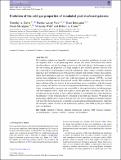Files in this item
Evolution of the cold gas properties of simulated post-starburst galaxies
Item metadata
| dc.contributor.author | Davis, Timothy A. | |
| dc.contributor.author | van de Voort, Freeke | |
| dc.contributor.author | Rowlands, Kate | |
| dc.contributor.author | McAlpine, Stuart | |
| dc.contributor.author | Wild, Vivienne | |
| dc.contributor.author | Crain, Robert A. | |
| dc.date.accessioned | 2019-03-04T11:30:10Z | |
| dc.date.available | 2019-03-04T11:30:10Z | |
| dc.date.issued | 2019-04-01 | |
| dc.identifier | 258040751 | |
| dc.identifier | d0c04fd2-52a4-4615-8b96-b4348a9f5bea | |
| dc.identifier | 85062863553 | |
| dc.identifier | 000462302600070 | |
| dc.identifier.citation | Davis , T A , van de Voort , F , Rowlands , K , McAlpine , S , Wild , V & Crain , R A 2019 , ' Evolution of the cold gas properties of simulated post-starburst galaxies ' , Monthly Notices of the Royal Astronomical Society , vol. 484 , no. 2 , pp. 2447-2461 . https://doi.org/10.1093/mnras/stz180 | en |
| dc.identifier.issn | 0035-8711 | |
| dc.identifier.other | BibCode: 2019MNRAS.484.2447D | |
| dc.identifier.uri | https://hdl.handle.net/10023/17205 | |
| dc.description.abstract | Post-starburst galaxies are typically considered to be a transition population, en route to the red sequence after a recent quenching event. Despite this, recent observations have shown that these objects typically have large reservoirs of cold molecular gas. In this paper we study the star-forming gas properties of a large sample of post-starburst galaxies selected from the cosmological, hydrodynamical EAGLE simulations. These objects resemble observed high-mass post-starburst galaxies both spectroscopically and in terms of their space density, stellar mass distribution, and sizes. We find that the vast majority of simulated post-starburst galaxies have significant gas reservoirs, with star-forming gas masses ≈109 M⊙, in good agreement with those seen in observational samples. The simulation reproduces the observed time evolution of the gas fraction of the post-starburst galaxy population, with the average galaxy losing ≈90 per cent of its star-forming interstellar medium in only ≈600 Myr. A variety of gas consumption/loss processes are responsible for this rapid evolution, including mergers and environmental effects, while active galactic nuclei play only a secondary role. The fast evolution in the gas fraction of post-starburst galaxies is accompanied by a clear decrease in the efficiency of star formation due to a decrease in the dense gas fraction. We predict that forthcoming ALMA observations of the gas reservoirs of low-redshift post-starburst galaxies will show that the molecular gas is typically compact and has disturbed kinematics, reflecting the disruptive nature of many of the evolutionary pathways that build up the post-starburst galaxy population. | |
| dc.format.extent | 2828589 | |
| dc.language.iso | eng | |
| dc.relation.ispartof | Monthly Notices of the Royal Astronomical Society | en |
| dc.subject | Galaxies: evolution | en |
| dc.subject | Galaxies: interactions | en |
| dc.subject | Galaxies: ISM | en |
| dc.subject | Galaxies: kinematics and dynamics | en |
| dc.subject | Galaxies: starburst | en |
| dc.subject | Galaxies: star formation | en |
| dc.subject | QB Astronomy | en |
| dc.subject | QC Physics | en |
| dc.subject | 3rd-DAS | en |
| dc.subject.lcc | QB | en |
| dc.subject.lcc | QC | en |
| dc.title | Evolution of the cold gas properties of simulated post-starburst galaxies | en |
| dc.type | Journal article | en |
| dc.contributor.institution | University of St Andrews. School of Physics and Astronomy | en |
| dc.identifier.doi | 10.1093/mnras/stz180 | |
| dc.description.status | Peer reviewed | en |
| dc.identifier.url | http://adsabs.harvard.edu/abs/2019MNRAS.484.2447D | en |
This item appears in the following Collection(s)
Items in the St Andrews Research Repository are protected by copyright, with all rights reserved, unless otherwise indicated.

